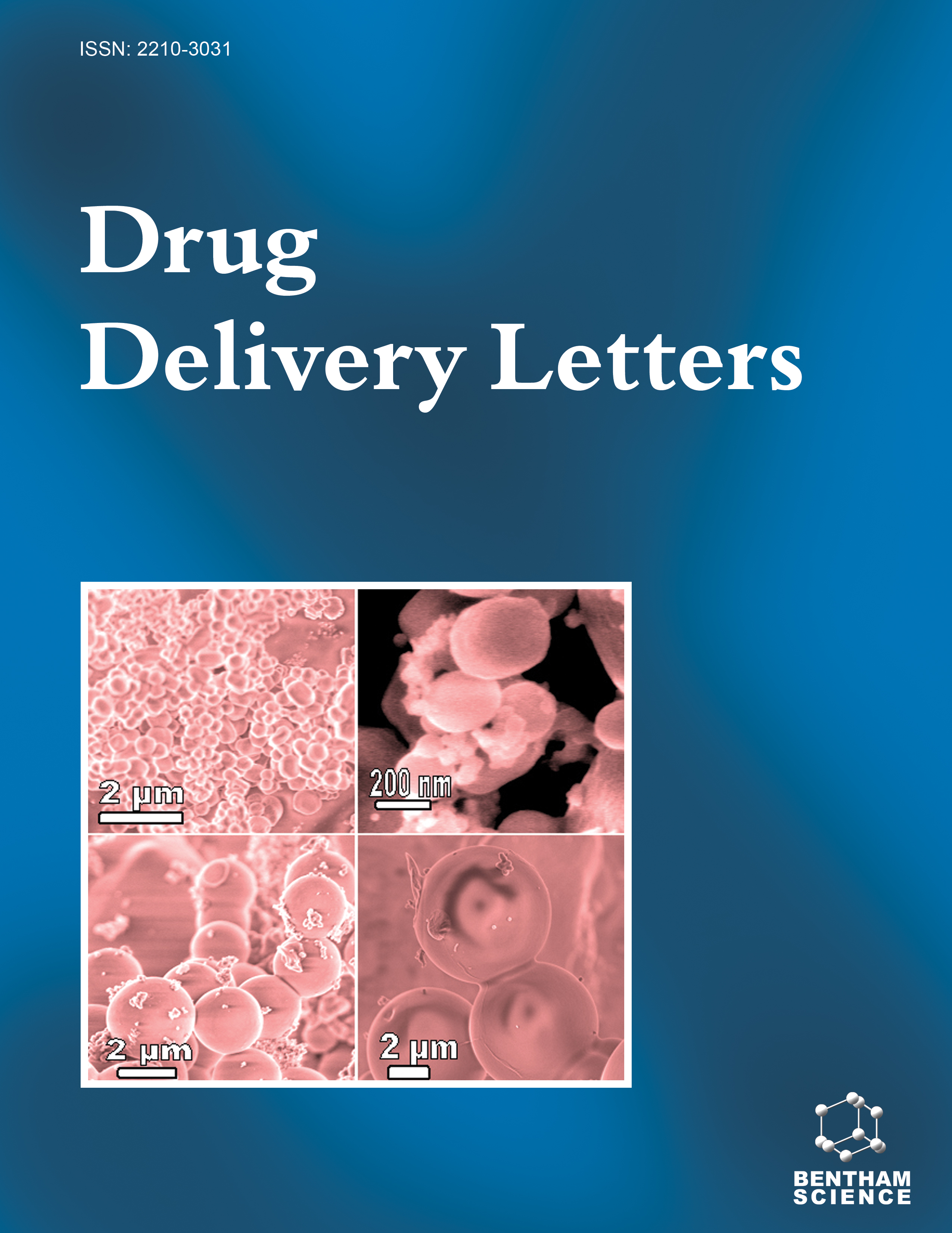- Home
- A-Z Publications
- Drug Delivery Letters
- Previous Issues
- Volume 2, Issue 3, 2012
Drug Delivery Letters - Volume 2, Issue 3, 2012
Volume 2, Issue 3, 2012
-
-
Characterization of Radiolabeled Dry Powder Leucine, a Constituent of Inhalable Capreomycin
More LessAuthors: Lindie Venter, Judith Wagener, P. Bernard Fourie and Jan Rijn ZeevaartReformulation of anti-tuberculosis drugs into dry powder particles for inhalation is a novel strategy that aims to increase therapeutically relevant drug concentration at the primary site of infection and to limit associated toxicity by avoiding or minimizing first-pass metabolism. Development of such formulations ultimately requires quantified evidence of the deposition, absorption and clearance of inhaled active ingredient. In thi Read More
-
-
-
Folate Conjugated Solid Lipid Nanoparticles of Carboplatin for Targeting Cancer Cells
More LessAuthors: V. Sankar, Shalini Devi Penmetsa and C. SabarinathThe present study investigates the specific drug targeting of anti cancer drugs, such as carboplatin by incorporation into folate conjugated Solid Lipid Nanoparticles (SLN). Our results showed that SLN 5 has the greater entrapment efficiency of 87.50% and slow in-vitro drug release (65.31% of carboplatin was released in 12 hrs) among all the SLN formulations prepared by high speed homogenization using 23 factorial design. T Read More
-
-
-
Integrating a Drug Release System into Textile Long Bone Implants by Dip Coating from Drug Suspension - Influence of Grain Size and Grain Size Distribution on the Releasing Profile
More LessTo reduce the risk of infection in the treatment of long bone defects, implant materials can be provided with an antibiotic drug delivery system. A novel bone implant for the tissue engineering of critical long bone defects was developed by stacking embroidered scaffolds, seeded with mesenchymal human stem cells. Controlled drug release is to be integrated in this implant by coating the thread material with antibiotic Read More
-
-
-
The Effects of Iontophoresis in the Treatment of Musculoskeletal Disorders - A Systematic Review and Meta-Analysis
More LessAuthors: R. Clijsen, J. Taeymans, J. P. Baeyens, A. O. Barel and P. ClarysThis systematic review and meta-analysis is focusing on the evidences related to iontophoresis used to enhance the topical drug delivery through the skin in the treatment of inflammatory dysfunctions, acute soft tissue injuries and pain. A literature search in the databases, MEDLINE (PubMed), Pedro, and the Cochrane Database of Systematic Reviews was conducted. The methodological quality of the obtained studies was indep Read More
-
-
-
Multi Stage Strategy to Reduce Friability of Directly Compressed Orally Disintegrating Tablets
More LessAuthors: Ali Al-Khattawi, Ahmad Aly, Yvonne Perrie, Peter Rue and Afzal R MohammedThe aim of the presented work describes the formulation of compressed orally disintegrating tablet (ODT) using α-tocopheryl polyethylene glycol 1000 succinate (TPGS) as a binder/disintegrant. Preliminary investigations were focused on process and formulation optimisation which resulted in ODT containing 2% wt. TPGS with reasonable hardness and acceptable disintegration time but with high friability. The next stage of the Read More
-
-
-
Formulation and In Vitro Evaluation of Solid Lipid Microparticles of Candesartan Cilexetil Floating Tablets
More LessAuthors: V. Kamalakkannan, A. Puratchikody and L. RamanathanHigh blood pressure (HBP) is a serious condition that can lead to coronary heart disease, stroke, kidney failure and other health problems. Management of HBP with the conventional dosage forms of the existing antihypertensive agents are challenging to the clinicians. Candesartan cilexetil (CC) is a newer class of antihypertensive agent which comes under angiotensin II receptor antagonist. The current commercial f Read More
-
-
-
Preparation and Development of Oral Controlled Release w/o/w Multiple Emulsion of Carbamazepine
More LessAuthors: Kalpana L. Ramchandani, Jigna D. Joshi, Anita N. Lalwani and Pragna K. ShelatThe purpose of this work was to formulate a controlled release multiple emulsion of carbamazepine favorable for administration in pediatrics and geriatrics suffering from epilepsy, decreasing the dosing frequency, thereby improving patient compliance and providing a platform for personalized medicine. Two–step emulsification procedure was employed for the formulation using liquid paraffin oil, water, surfactants Read More
-
-
-
Formulation and Evaluation of in vitro Cytotoxicity of Carboplatin Niosomes
More LessThe goal of our study was to prepare carboplatin niosomes for enhanced delivery to cancer cells by thin film hydration technique using (cholesterol: surfactant) in the micromolar ratio of 30:100 and with/without the addition of charge inducing agents and Pluronic F 68. Photomicrographs of the formulations show the presence of multilamellar vesicles in the forumulation with Tween 80 and Pluronic F 68. The vesicle size of the for Read More
-
Volumes & issues
Most Read This Month
Article
content/journals/ddl
Journal
10
5
false
en


